#traditionalist architecture
Explore tagged Tumblr posts
Text
one other thing since im here now. a lot of people's arguments against brutalism that I've heard are like "but wouldn't it be ugly and depressing if it was only plain concrete as far as the eye could see?" girl WHO is saying that !!! ofc im not advocating for total urbanisation or concretification because i know the implications that has for the environment and i know the importance of nature being allowed to flourish in urban spaces. also why do u think brutalism means everything is the same! it isn't a monolithic movement there isn't one type of brutalism. why would u assume im advocating for homogenisation VARIETY is IMPORTANT. a combination of brutalism and ecobrutalism and green spaces and other styles of building are all important in a city and i recognise that and whenever I talk to a brutalism hater they always pull those stupid straw man arguments out of their ass 😭 not to mention brutalism is about more than just concrete its space + height + dimension + angles + accommodation + above all its about the people who live in those buildings !! the thing that sets urban brutalism apart from other buildings is that it is a blank canvas that allows for murals and grafitti and ecological adaptations and that's not me saying brutalism is only good when it's covered up im saying that in an ideal world it would encourage adaptations and an emphasis on the community which includes exterior decoration. things like neoclassicism or the tudor style and terrace housing, that you find in a lot of western Europe for example, already have all the finishings and embellishments that the architect imagined and when someone grafittis a gothic or neoclassical building its seen as defacing or vandalism, but in a brutalist/modernist cityscape i think it should be encouraged. you can never understand the vastness and colourfulness of my beliefs. Asshole
#sorry im still sore abt a conversation i had with this guy yesterday he was soooo fucking stupid#stupid traditionalist neofascist talking points 😦😦😦 like what he hated was just modernism and commies ok. say it with ur chest#anyway. next person who says something negative or ignorant abt architecture gets a kick in the teeth
11 notes
·
View notes
Text
Writing Notes: Art Deco

Art Deco - a style of decor and architecture that peaked in international popularity in the 1920s and 1930s and includes modern design elements combined with sophisticated craftsmanship.
The design movement is further characterized by geometric shapes and a bold color palette; the use of metals or metallic details; glam fabrics with patterns; and figures from Greek and Roman mythology.
Depending on the geography and time period referenced, it can vary widely.
While early styles were bursting with often clashing colors, the Great Depression ushered in a more minimalist approach and muted some of the excesses of the initial art deco designers.
The deco era has experienced a resurgence in recent times, thanks in part to Hollywood films that heavily feature the aesthetic, such as Chicago (2002) and The Great Gatsby (2013).
Elements of Art Deco Decor Design
Art deco decor and architecture can vary, but here are some of the characteristics practically synonymous with the style of the deco period, today considered to be somewhat retro in style.
Geometric shapes: Key art deco elements include geometric designs such as sunbursts, which are sometimes deconstructed into circles and triangles; zigzag patterns, which may vary from stacked chevrons to houndstooth patterns; and scalloped patterns, which combine aspects of both sunburst and zigzag shapes. For example, a screen meant to divide a dining room from a living room may feature rounded, scalloped curves at the top instead of flat edges.
Bold colors: Bright colors are characteristic of the art deco style, sometimes appearing in clashing combinations but always in vivid, gemstone hues, such as in colored glass in a sconce or chandelier, or in color-saturated wall decor that draws the eye.
Mythological figures: Figures from Greek and Roman mythology, or heavily mythologized modern stand-ins, feature prominently in art deco interior design, such as posters, light fixtures, and other objects. Art deco artists also flourished in the medium of sculpture, and some of the most enduring symbols of the style are found in sculptures in major cities around the world.
Various metals: Exterior art deco architecture and designs favor the use of chrome and stainless steel, especially in combination with concrete. Smaller works, such as a table lamp, may feature intricate inlays of more precious metals. In the absence of actual metal, art deco styles may include materials or visual elements intended to appear metallic in nature.
Luxurious, patterned fabrics: Art deco furniture upholstery usually features expensive or expensive-looking fabrics and brightly colored geometric patterns to further indicate opulence.
Lacquers and inlays: Finishing touches like a glossy lacquer on a counter or an exquisite, patterned inlay—made of expensive materials like gold or ivory—are representative of art deco in that they are at once sleek and modern while also showcasing a high degree of craftsmanship. Lacquered elements can appear on stools, side tables, coffee tables, or any surface where they will be admired and enjoyed.
A Brief History of Art Deco
Art deco decor and architecture first emerged early in the 20th century, but the style is still popular today.
Emergence in France: Art deco (arts décoratif in French) first appeared in France around the time of World War I, which began in 1914. Art deco was a reaction to the preceding art nouveau period (characterized by intricate, swirling designs)—an effort to bring back elements of traditional art and combine them with modern materials and craftsmanship. The style reached its peak at the 1925 Decorative Arts Exposition in Paris and dominated architecture and interior design ideas around the world.
Divergence of styles: By the late 1920s, the art deco look had split into two different schools of thought and style. The traditionalists wanted to pair the modern forms of home decor and architecture with traditional craftsmanship; the modernists embraced new materials, new technology, and mass production in favor of a more streamlined approach to design.
Emergence in New York: Art deco architecture and visual arts is closely associated with the city of New York, one of the cities where the style first appeared in the United States during the ’20s and flourishing into the 1930s. New York still has many skyscrapers and other examples of art deco architecture, such as Rockefeller Center, the Chrysler Building, and the Empire State Building.
Embrace around the world: Major international cities welcomed art deco design elements into their own decor, art, and architecture, and you can see examples of this style in mosaics, sculptures, and buildings in Brussels, Bucharest, Chicago, London, Mexico City, Miami, Moscow, Rio de Janeiro, Tokyo, and other cities.
Source ⚜ More: Notes & References ⚜ Writing Resources PDFs
#art deco#art#writing notes#worldbuilding#writeblr#writing inspiration#writing ideas#light academia#writers on tumblr#writing reference#architecture#literature#spilled ink#dark academia#writing prompt#history#design#creative writing#writing resources
101 notes
·
View notes
Text


With the currency reform of 1948 the German government heralded the start of the Wirtschaftswunder, a one and a half decade long boom of the German postwar economy. Along with it went a construction boom since wartime destructions had to be made up for and the influx of refugees from former eastern territories had to be absorbed and accommodated. In 1960 the different professional associations of architects, engineers and landscape designers published „Planen und Bauen im Neuen Deutschland“, a comprehensive compendium of a carefully selected postwar architecture: as the book’s title indicates traditionalist designs would have been contrary to the authors‘ intention to depict Germany as a modern state to be reckoned with and thus it almost exclusively features cutting-edge designs. Structured along typologies the book is a performance show of contemporary architecture and infrastructure in Germany, both state and privately owned. Together with the countless illustrations this really makes for perfect Sunday musings about postwar architecture in Germany.
24 notes
·
View notes
Note
I was thinking about Duergar after listening to Critical Role S1. I don’t care too much for the blatantly evil brush they used but I still want them to be antagonistic. Reading the Explore D&D article on them I took that and looked for inspiration. I thought a blend of the paranoid police state of Stalinist Russia with the political intrigue and back stabbing of imperial Rome. Vast underground cities of brutalist architecture. A culture of conformity, order and a nihilistic outlook. Atheist philosophy cults of the forge or other practical oriented ideologies. Power by any means is a virtue in this society so mages and warlocks are also prevalent. Holidays and celebrations are scheduled well choreographed events. Individuality is scorned. Even hair styles and clothing are limited and enforced by literal fashion police. Gulags are kept well stocked with routine purges of dissidents and a thriving slave trade. All this keeps their cities nearly impenetrable but also undercuts their expansion. Trade with the outside does exist but it’s extremely bureaucratic. They make FANTASTIC concrete.
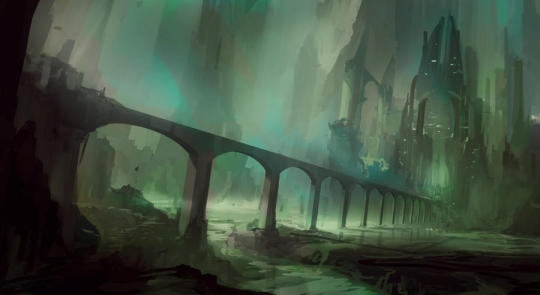
Footnotes on Foes: Duergar
The problem with the grey dwarves is that they're a little too close to their surface world counterparts compared to the other underdark Wario fantasy races. There's a literal night and day difference between elves and drow , humans and grimlocks, and to a lesser extent gnomes and svirfneblin, but if you looked at surface dwarves (traditionalist, work in metal and stone, warriror culture) there's really nothing all that different about the Duergar other than a grabbag of magic powers and the Duergar being SUPER assholes all the time, while surface dwarves are only assholes some of the time.
I’ve tried a few different versions of the duergar in my writing including mercenary legions of migratory exiles hunting through the underdark looking to conquer territory, and willing collaborators and footsoldiers for illithid colonies, but I think this ask specifically gave me something cool to work with: A focus on Psionics is what ahould seperate the duergar from regular dwarves, with the totalitarian state described above ramped up to its fantasy world extreme by the fact that the secret police can read your mind, and if they can’t find evidence of thoughtcrime they can use mindfuckery to put it there. The social conformity is seen as a way of detecting rebellious thoughts as if they were social contagion.
This also gives the grey dwarves a distinct aesthetic that is separate from vanilla dwarves: Crystals, be they shaped into weapons or architecture or floating about the heads of psionic casters, which goes to supplement their already textual psychic powers. As an added means of differentiating them, talk about how duergar metalwork is shit, soldiers wearing slave-foundry pig iron while their commanders wield elegantly carved sceptres of nightmare infused rock.
Also, just to have a bit of fun, have the duergar low-key anxious about the existence of the sky, to the point where many of them believe it's a myth made up to scare them as children.
Hooks:
Despite the draconian control they keep over their own populace, the rigors of living in a realm of ever shifting stone require the Duergar to utilize numerous means to secure the territories around their grim cities: Fortress outposts built to control passage in and out of their cavernous realms, psionicly propelled vessels of iron plate that prowl great tunnels like levitating battleships, treaties and client-state contracts with rival and subjugated creatures set up as buffers. Travelling through underdark controlled by duergar is a different sort of dangerous then normal travel in the below.
Escaping from prison before she could be lobotomized, a powerful psion has made it to the surface world with a gang of fellow thought-criminals, working as mercenaries using their unusual skills and eventually forming a rivalry with the party.
The earth writhes. A series of violent quakes cause damage in several cities across the kingdom, setting off numerous small disasters and the appearance of subterranean monsters that'll keep the party and the powers that be busy for weeks. When the cause is eventually determined, it's discovered that in a hunger for more pisonically charged crystals, a duergar warlord has awoken a primordial which now thrashes against its restraints and shakes the world as its pained excavation continues.
Art
200 notes
·
View notes
Text
I spent several hours yesterday just. Drawin ponies and makin headcanons after an offhanded thought i had abt changelings lol
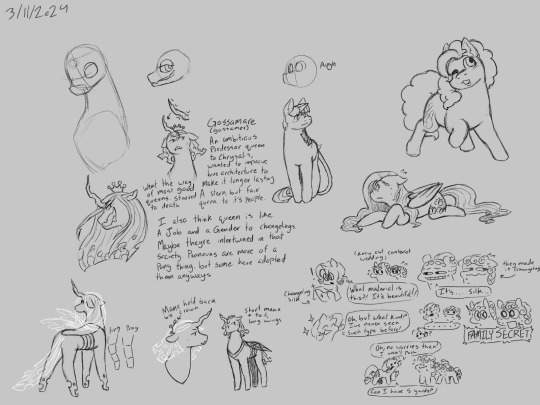

Also a buncha headcanons under the cut also:
Thinking more abt Gossamare (changeling queen oc i just made up .5 sec ago). She was plenty ambitious, as most queens are, but her attentions were turned more towards making sure the Hive had stirdier, longer lasting structures. The reasoning was if there was less time being spent rebuilding their home after an attack, or if smthn just crumbled, than that was less stress and more energy that could be spent Elsewhere (like getting food). I think changelings were pretty nomadic as a species beforehand, and while Gossamare didn't introduce a sedentary lifestyle, it was still a fairly new thing, so permanent architecture wasnt really. Good. So it fixed that. Discovered changeling-equivalent concrete, except better bc it was also pretty damn flexible. And self repairing to some extent. Stole architecture from ponies. Even talked with celestia a few times (also fought celestia a few times) (bc she was stealing. It got cleared up but Still). Was stern and kinda strict but Fair. Left its hive in a pretty prosperous era, even if the queens after the next fumbled it kinda badly.
Genral timeline idea: crystal empire era -> [queens after it falls] -> [queen who became sedentary] -> [queen] -> [queen] -> Gossamare -> [2-3 generations of queens] -> Chrysalis -> Thorax (will be poking at this more as i figure out more changeling things, i want the crystal empire to be kinda far back in changeling history, a legend, but not quite mythical status)
Ideas:
• Changelings were nomadic, though they generally (peacefully) stayed around the crystal empire just bein buddies. Cue Sombra fuckin it, and bam. No more good food source and also their buddies are gone. And its Cold. Changelings skeedadle, become true nomads, separate into diff hives for whatever reasons and settle into different nations. Now following the hive that settled into equestria, changelings are. Wary. Decide to stay hidden. Prob the traditionalists+idealists who didnt want to stray too far from the empire in case it came back soon. They settle, roam around, til one day a queen just plops down and doesnt move. Thus the end of the nomad life, although changelings still have little satellite location away from the main hive. Just lil bases and shit yknow? Still not super fond of this enforced hiding thing, but reveals tend to always go super bad, if not from the get-go, then some shit happens later that usually kills the parties in question. So. Hiding it is.
• (Re; the crystal empire: canon says its been gone 1k years, but LUNA was gone 1k years, so ive decided its maybe like. 7k years for the crystal empire. Or just, longer than 1k!!! I want that to be a collective fail on Celestia AND Luna's part, not just Celestia)
• Theres probably stories in changeling history referring to crystal ponies, and a good portion of the empire's population are changelings, or have changeling heritage. Possibly when changelings intially fled, there were a good portion of crystal ponies among them, but their descendants are now just changelings (maybe with a slight sparkle, or having an easier time shifting into ponies.idk)
• When the Crystal empire returned, there definitely an awkward readjustment period, not only from Sombra's tyranny, but that a solid third or more of their population was now... disdained, to put it lightly, by other ponies and now also their new monarchs! And when they found out about the whole Canterlot wedding incident, well. They kept that to theirselves. Its not til Thorax is accepted as a citizen that the crystal ponies reveal that some of them are crystal changelings as well, and it goes over-! Pretty well! A little strained, and more awkward readjusting happens, but overall it goes well (Cadence is pretty sad that she made her citizens feel they had to hide this, but understands. Thorax is mildly upset but it puts some earlier events before that episode happening into better perspective)
• Queens generally die one of 3 ways: Being overthrown and killed, dying against an enemy, or starving bc the amount of love gained can no longer support their appetite. Generally the 3rd happening tends to cause the first, as sometimes those particular queens will start eating into the stores of love meant to support the hive as a whole, thus starving the entire hive along with her. So the hive kills her to stop that. Other times the queen will go out as gracefully as possible, either dying against an enemy in combat, or simply. Starving. Its stressful as fuck to watch, esp if the changeling respect that queen, even if its known to be the better of several options. Theyre generally pretty long lived (abt 500 years give or take) but when its over its Joever (at least until Thorax but not talkin abt that).
• Job is ya gender. Changeling language doesnt really have singular pronouns, mostly just [job][description][name] type deals. Queens have special pronouns though. Changelings have also adopted pronouns from other languages sometimes, but it tends to be more of a like. Curiousity than anything super serious
#THIS HAS NO TAGS WTF#my little pony#mlp#mlp changelings#changelings#queen chrysalis#twilight#pinkie pie#fluttershy#mlp oc#princess celestia#crystal pony#nighty arts#sketch#headcanons
32 notes
·
View notes
Text
Saw a post on Finish your WIPs February and I was not going to do any of that, except Solas and Iwyn insisted. It was fun writing them again.
Originally started in 2021, for a kinky bingo prompt of "infidelity", here's Solas and Iwyn enjoying some art, and each other - acting on their attraction to each other after Iwyn's husband leaves.
Fandom: Dragon Age | Words: 4114 | Read on Ao3
Iwyn Lavellan x Solas | Modern AU | smut Rating: Explicit. Infidelity, smut, fluff, angst, Iwyn is lonely, her husband is a bit boring, Solas is lonely too, nothing new here though, oral, piv sex, safe sex, casual relationship
Casual Fun
There is a surprising amount of rich, beautiful people at the museum. Solas knows many donors are more interested in getting their name in the brochures – or even better, in brass on the entrance pillar –but they still attend events to mingle and make sure everyone else knows they are there.
It’s still more crowded than he anticipated. The foyer is busy, a string quartet plays, and the trays of canapes and sparkling wine are quickly refilled.
The patrons of the arts, all dressed up. It doesn’t matter why people are here – the museum is free Wednesdays and Sundays, and hands out scholarships to young artists and that matters. Solas doesn’t much care about making connections or socializing, but he does care that there is money for the arts, and this is why he donates himself, of course.
It’s the opening of the A. Brenhan exhibition – a renown Orzammar artist who rarely allows his works to be shown on the surface. Solas had hoped to see the collection relatively undisturbed, and initially the throng of people had dashed his hopes. When he makes his way to the special exhibit on the second floor, he realizes he was wrong. Very few people wander the exhibit. It seems everyone is more interested in the spectacle that is themselves.
He spends some time on the charcoal sketches. It’s mostly architecture. Forgotten Thaigs and empty corridors and old houses. The story behind them is more interesting than the sketches themselves.
Most people actively browsing the gallery are in pairs or small groups. Like himself, they might have a more serious interest in the art, or simply worry about missing out. While he appreciates the peace and quiet here, he does wish he had someone to discuss the art with.
Solas moves to the next part of the exhibit, what Brenhan is most known for. Oil paintings on large canvasses, larger than Solas is tall. The kind of work you hang in museums, or maybe in mansions of some of the very rich. No matter, the artist’s fame is well deserved. Most of the paintings feature Dwarven architecture, ancient and modern both, but above them an impossible sky. Brenhan is a traditionalist, and has never left Orzammar, and doesn’t truly know what the sky looks like. The effect is eerie and unsettling, and meant to be so.
“I can’t decide if I love it, hate it, or just find it odd.”
Solas is startled by the woman next to him. He’d not noticed her, or assumed she was part of the group that moved on.
“It’s captivating nonetheless,” he offers.
“I agree. It’s one of the more interesting exhibits recently.”
He turns to her, and she is captivating too. Her dress is a shimmery white, contrasting with her tan skin and red hair piled on top of her head. Diamonds drip from her pointed ears and her green eyes sparkle. As she moves, his eyes are drawn to the high slit in her dress and her tall heels.
He quickly looks back at her face, and she smirks at him.
“Do you often attend the openings?” he asks, and realizes this is almost as cliche as do you come here often? He wanted someone to talk to, and now he wants to sink into the floor.
“Most of them, if I can.” She smiles and holds out her hand. “I’m Iwyn.”
He takes it, and she gives a firm handshake.
“Solas.”
“So, Solas, are you familiar with Brenhan’s work?”
“Some. I have not seen such an extensive collection before. From what I understand it is the most comprehensive exhibition of his works. Outside Orzammar, of course.”
“Yes, I’ve heard so too. I did see some of his work in the Museum of Modern Art in Denerim, but it was only a few. I do find his work intriguing, and a lot more impressive in person.”
“It’s the scale of it. It doesn’t translate well to a catalogue.”
Iwyn agrees and they talk more about the paintings, moving from one room to the next in the exhibit. He learns that her interest in art is recent, and he has plenty of knowledge he can share with her. Her own insights are unique and interesting still, seeing the soul and emotion of the pictures without the baggage of art study. The conversation is invigorating and easy.
Sometime later, an elven man joins them. He’s a little shorter than Solas, with a square jaw and long dark hair gathered in a bun at his neck. He leans over and kisses Iwyn on the cheek.
“Hello, dear.”
“Solas, this is my husband Halier. Halier, Solas is an art enthusiast and he’s been sharing interesting thoughts on the exhibit.”
Solas heart drops in chest and he instinctively puts space between him and Iwyn. He’s enjoyed their conversation immensely, and working to steer the conversation away from the art and towards leaving for drinks. Like a fool, he’d ignored the large diamond ring on her finger. It went with her earrings and bracelet.
Halier grunts and thrusts out his hand, and Solas can do nothing else but take it.
“Solas. I’m sure I’ve seen you before – where do you work?”
“I’m a partner at Evanuris Wealth Management.”
“Of course. I must have seen your picture in your office. I’m a partner with Lavellan, Lavellan & Sabrae Law Firm.”
“Very nice.”
Solas isn’t here to discuss business. Most days, he doesn’t hate his job, or the family business, and he’s glad it allows him to support the arts like this, but he also doesn’t want it to consume his life. He isn’t here to discuss business.
“Are you done here?” Halier directs his question at Iwyn, but does not wait for her response. “I’d like to get out of here, I have that early flight tomorrow.”
“I wouldn’t mind staying a bit longer. Take the car, I’ll grab a cab.” Iwyn fishes a valet ticket out of her clutch, and lightly kisses Halier’s cheek. “Don’t wait up.”
“I won’t. I have to be at the airport at 6am. Goodnight, dear.” He takes the ticket, and nods at Solas. “Solas, nice to meet you. We can discuss business at some other time, perhaps. Thank you for entertaining my wife.”
“A pleasure.”
Solas watches as Halier leaves, but his attention is soon back on Iwyn.
"My husband finds these things terribly boring,” she says. “We're donors, and he likes his name on something cultured along with the tax deduction, but that's it."
"And you don’t find these things boring?"
“I like the events, and the art. Especially with interesting company.”
He doesn’t know how to interpret that, with her sly smile and sparkling eyes and husband retreating down the stairs.
“The art is certainly better with good company.”
He closes a little of the space between them, and he wants her to forget her husband existed. Fuck.
“I’d love to look at the final part of the exhibit. Do you want to join me, Solas?”
She brushes past him, her fingers skimming his arm as she gestures towards the last room they have not explored. He’s no idea if it’s deliberate, but the heat of her sears him through his jacket.
They spend another thirty minutes, at least, taking in the final room. The art is interesting, but more and more he finds himself staring at Iwyn. She catches him, at one point, causing him to quickly avert his eyes and stumble over his words.
Iwyn puts a hand on his arm.
“How about getting some drinks? It seems you’ve lost interest in the art.”
“I’m looking at a different type of art, even more interesting and beautiful.”
It slips out before he can stop himself, but she just gives him a crooked smile.
“Let’s get out of there, Solas.”
-
Iwyn takes Solas to a nearby bar. There’s a risk someone would know her and her husband, of course, but she’s willing to take it. Halier already knows she was talking with him, and they’re just here to talk a little more. Maybe, she admits, she wants to more than talk. She likes his eyes on her, the intensity in them when he looks at her. She likes his voice, and the way he called her beautiful just earlier. Brazen and rebellious.
The bar is nice enough, a regular upscale bar matching the surrounding office buildings, galleries, art museum, restaurants, and symphony hall. She thinks it was featured recently in the nightlife section of the local newspaper, but she isn’t sure. Iwyn orders the featured drink, The Divine’s Night Off, with crystal grace infused gin, brown sugar syrup and Navarran orange liqueur. Solas orders a fruity pink grapefruit vodka concoction.
They make careful small talk, at first. About art, and the museum and the ballet (Solas is a fan, Iwyn isn’t) and other arts that the city offers. They carefully avoid talking about work or what Solas does for a living. It’s clear that his company and her husband’s do some business, and she doesn’t want to think about that.
“I don’t think I’ve seen you at the donor evenings before. We – I try to go to most of them.”
“I have been a donor for a while now, but the last two years I’ve been in Kirkwall. For work.”
Solas makes a face, and she grins. No one really likes Kirkwall, not even the people from there.
“Happy to be back in Wycome?”
“Most certainly. Kirkland is boring at best, and polluted and prejudiced at its worst. It is a relief to be back. Though I must say that I did not expect the event to be that enticing.”
His voice sends shivers down her spine.
“I’m very glad you’re here, Solas. It made my evening a lot more exciting so far.”
“So far?”
“It could become more exciting.”
“How so?”
“I’m sure you can figure it out.”
She’s bored and lonely most of the time, if she’s honest, and Solas offers something new and different. She wants his hands all over her. She wants to fuck him. There are many reasons she’s still married to Halier, but mediocre sex isn’t one of them. She never thought of meeting someone like this, flirting like this. The thrill of it is lightning in her veins, and the fact that Solas knows about her husband intensifies it.
Solas takes a sip of his drink, and traces the edge of his glass. His fingers are long and elegant.
“I would very much like to. Figure it out, I mean.”
She’s made up her mind, and she doesn’t want to wait anymore. Iwyn is out of her comfort zone, but there is something about Solas that draws her to him. She needs to know if he feels the same, and she’s no reason to hide her intentions.
“Sweet talker.”
“Iwyn, I…” He pauses, and looks serious. “Tell me if you want me to stop.”
“Solas,” she says, as she reaches across the table and places her hand on top of his. “I know a hotel, nearby.”
“Yes,” he replies, to the question she didn’t ask.
They pay for their drinks and slip out into the cool night. It has rained while they were at the bar, the wet sidewalk reflecting the lights from the street. Boldly, Iwyn pulls Solas close and kisses him, soft and quick. He freezes, and she’s about to apologize when he pulls her close again and kisses her back. This time there is nothing soft or gentle about it.
“We should probably find that hotel,” she mumbles when they pull apart. As much as she wants to keep him close, she also wants him naked. Solas seems to agree, nodding and taking her hand. It’s only two blocks to the hotel, and they manage without too many stops for kisses. The entrance is well lit, gold handles in the glass doors.
She hesitates in the lobby, but only briefly. She is certain. Solas hand is at the small of her back, as if it belongs there. As if they’d checked into a hotel together a million times before.
“Can I help you?”
The human behind the counter looks very bored. It’s quite late, and the lobby is empty.
“We need a room for a night. We don’t have a reservation.”
Solas is close and she draws on the confidence in his presence. He wants to be here. She wants to be here. What they’re doing is no one else’s business.
“Sure.” The girl taps on her computer. “Nightly rate 399. Credit card and Id, please?”
“Let me,” Solas says smoothly, and she supposes he right. It’s not that she can’t pay, but it’s better it’s not her name. Some part of her doesn’t care, craves the danger of it. But she’s not quite ready to self-destruct her life.
Solas hands over his cards, and the girl dutifully enters his information into her system. She hands them two keycards. She looks too tired and underpaid to ask about their lack of luggage.
“Room 906, elevators are down and on your right. Checkout is at 11am tomorrow.”
Solas thanks her, hands Iwyn one card, and starts down the hallway. Iwyn grabs his hand.
“One moment.”
She heads to the hotel convenience store, determined and casual all at once. She looks at the little stand of toiletries – deodorants, cotton buds, razors.
“Do you have any condoms?”
The dwarf behind counter grunts, and pulls out a silver cardboard box from a cabinet behind the counter.
“19.99.”
She hands him her credit card, and puts the box in the purse when the transaction is complete. The dwarf grunts again, and fiddles with his phone.
Iwyn hurries after Solas, and puts her hand in his when she catches up.
-
They slip inside the room, and the door closes with a soft thud behind them. Iwyn pushes him against the wall, and catches his lips in an eager kiss. He slips his hand through the tall slit in her dress, caressing her skin, like he’d been wanting to all night. He kisses her neck, she gasps.
“You’re so beautiful,” he says. He pulls back and really looks at her. A thought occurs to him. “Does your husband know you’re here?”
He isn’t really certain why a beautiful woman wants with him, and her husband is certainly handsome enough. If he’s part of someone’s kink he’d like to know.
“No. Does that bother you?”
He shakes his head.
“Good.”
Iwyn walks to the bed, and drops her dress on the floor. It pools around her feet, leaving her nude except her lace panties and tall heels. She twists off her diamond ring and drops it on the bedside table.
“He won’t know anything,” she states.
She is breathtaking. He tentatively touches her arm, her shoulder. Runs his fingers across her collar bone, and down her chest. She gasps when he cups her breast briefly, before skimming over her ribs, resting his hand on her hip. He follows with kisses, all the way down the body until he kneels before her. He frees her legs from the dress, folds it, and toss it on a chair.
“If he did know – your husband – would you be in danger?”
She laughs at this, and cuts herself off. She looks at him earnestly.
“Thank you, Solas, for asking. I wouldn’t be. He would be severely disappointed, I suppose. Just like he severely disappoints me.”
He kisses her knee.
“I will endeavor not to, in that case.”
“Very good.”
The way her voice drops when she praises him sends a bolt of arousal straight to his dick. So does the fact that she’s here, with him, while her husband has gone home alone.
He runs his hands up her legs, and kisses her lace covered sex. She gasps, a low involuntary sound, completely lovely.
“Sit down, please?”
She does, sitting herself on the bed behind her. Before he can lean in closer, she lifts one foot, pressing her heel against his chest.
“You’re overdressed, Solas.”
“Of course.”
He takes off his jacket, and unbuttons his shirt. Iwyn crosses her legs, and follows every move with hooded eyes. He hopes he measures up. With his chest bared he leans over her and kisses her, deep and hungry.
“Everything, Solas,” she says.
He complies, taking off his shoes and dresspants and socks and boxers. There’s no elegant way to go about it, but Iwyn is just sitting on the bed, leaning back on her elbows with a small smile on her face. She smiles wider when he’s finally naked, and he’d happily suffer a little awkwardness to put such a smile on face.
Iwyn uncrosses her legs.
“Now where were you?”
Solas slides down in front of her. “Right here, I believe.” He slides his hands up her calves, past her knees. She yields to his gentle pressure, and lets her legs fall open. He kisses the inside of her thigh, and again, his lips caressing her silken skin all the way up to her lace clad mound. He kisses the lace, and she moans deliciously when he breathes hot air against her. He draws his head back to look at her, glorious above him, and caresses her with his fingers. He slips two inside her panties, touching her slick heat. Iwyn bucks against him, his other hand firmly holding her left leg.
“More,” she growls, and he draws her panties aside, leaving her clit exposed, pink and swollen. He teases it, and rubs against the sides of it, and then he presses down on it.
“Like this? Softer? Harder?”
“Harder, softer. Alternate.”
He smiles, and does as she asks, causing her to gasp and writhe. She is alluring, her half-covered sex arousing, her wet cunt inviting. He wants to taste her, to make her scream. He keeps working his fingers, and kisses the inside of her thigh. When he reaches the top, he licks up her cunt, reveling in her taste. She moans, a deep throaty sound and he groans too. He looks up at her, her shiny red lips parted, her cheeks flushed with desire.
“More?” he asks.
“Yes, please. Now.”
“I think I’ll get rid of these first.”. He smirks at her, moving his hands across her panties. They’re pretty, but in the way. He pulls the fabric a little up, making the lace rub against her clit, and then down. She lifts her hips easily, allowing him to slide them all the way down her legs. He carefully pulls the panties over the heels of her shoes, leaving them on her feet.
He doesn’t tease this time, no matter how inviting the soft skin of thighs is, but sits right up between her legs and spreads his palms over her hips. Her legs part wide for him, and he lowers his mouth to taste her again. He licks and sucks her sensitive folds and her swollen clit. He’s rewarded with a low moan, her head thrown back. He adds his hand, his fingers teasing her opening. Iwyn takes the opportunity to throw her leg over his shoulder. She’s wet and soft, clenching around his fingers, her juices coating his chin. Her heel digs into his back, pressing him closer to her, a beautiful counterpoint to her sweet taste.
She is all his, right here, even if it isn’t so outside this room. Not that she belongs to anyone but herself, not truly.
Solas keeps working his fingers, his tongue until she shudders around him, moaning and trashing against him. He lets her come down carefully, gently easing her out of her climax. Her leg slips to the floor and she relaxes into the bed.
“That was – very good.”
“Yes?”
“You did good,” she says again, firmer this time. His already hard cock jumps at it. He wants her and he wants her approval more. He wants to be good enough for her. He’s here with her, and her husband isn’t. He’s the one who slides his hands all the way down her legs, and gently takes off her shoes, kissing her ankles. He’s the one who crawls into bed after her when she swings legs up to stretch out on it.
He’s the one who asks her, “what can I do next?”
“Touch me,” she says. “Like you care.”
Solas is suddenly furiously angry, overcome with a need to punch Iwyn’s husband in the face the next time he meets him. He won’t, of course, and refocuses his attention on Iwyn. He just met her tonight, but he does care. He wants to touch her, to please her, right here in this downtown hotel. He also wants to talk art with her again, to get to know her better. He shoves that thought to the back of his brain. Being the one the satisfy her will have to be enough.
“I do care, Iwyn.”
She looks stunned at his earnestness, perhaps like she regrets her vulnerability. He patiently lets his fingers wander up her torso, feather-light. Iwyn recovers and smirks.
“Get on with it, then.”
He does, his hands wandering across her chest, teasing her nipples as he dips his head to kiss her. He learns what makes her moan, what makes her arch her back. Her hands are not idle either, sliding up his body, digging into his shoulders. He groans when she traces one finger up his cock, and wraps her whole hand around it. She pumps it slowly and all thoughts flee his mind, his hands randomly touching her, needing to feel her skin beneath his hands in any way he can. Iwyn sits half up, and kisses him.
“Lay back, Solas,” she says, extracting herself from under him.
He does, laying back and lets her continue to do as she pleases. Her hand is back on his cock as she grins, her other hand holding him firmly down when his hips jerk. He’s so hard it aches, and he almost can’t hold it together when moves faster, twisting her hand a little.
“I’m going to fuck you.”
“Please, please, Iwyn.” He’s ready to beg for anything, has been since he first laid his eyes on her.
She lets go of him, and finds the packet of condoms, opening one. Her nails are expertly manicured, a deep green color. The diamond bracelet glints against her wrist. She rolls the condom over his cock.
Seated above him, she drags her nails across his chest, her cunt hovering out of reach. He wants. He needs, he needs her now.
“Please,” he says again. “I need – “
She lowers herself on him, heat surrounding him, perfect and far too slow. When he moves, thrusting his hips up impatiently, she puts a hand on his chest.
“Stay still.”
Her eyes are burning, and it’s not a question. A demand. A test. He complies and grows impossible harder. Iwyn moves with agonizing slowness. His hands find their way to her waist, supporting, but not changing her pace, letting her stay in control. They’re both panting, eyes caught in each other.
Finally, Iwyn moves faster, leaning more on her weight on his chest as she collapses a little forward. He grips her hips tighter, and she nods. Now he moves with her, into her. It’s tight and hot and wonderful, and he moans her name as he throws his head back. Iwyn brings her own hand between her legs, and they both move faster, erratically. She trembles above him, glorious and beautiful, and his own orgasm takes him by surprise, intensity coursing through him.
Iwyn collapses fully on his chest, and he wraps his arms around her. She sighs and kiss his neck, as she slides off him, then tucks herself into him. Solas deals with the condom, and lets himself enjoy her warmth next to him.
"I don't normally do this," she says.
"Neither do I."
"Fucking a married woman, or engaging in one-night stands in general?"
Both. Either. He just nods, and kisses her brow. She idly caresses his shoulder. It feels far too comfortable.
“I’m glad I did,” she says.
“As I am I.”
They lay intwined, and he holds her. A minute. An hour. A moment. Long enough to pretend this belongs to him.
She slips away well before dawn. Home, he supposes, to her husband, or an empty bed he has left. Back to her real life.
She kisses his cheek.
"Thanks, Solas. I had a good time."
He squeezes her hand.
"Me too," he says, and he smiles, as wide and genuine as he can.
Casual fun, another man's wife.
The door clicks shut after her.
#dragon age#dragon age fanfic#solavellan#solavellan fanfic#iwyn x solas#writing about Iwyn#AHH it was so nice to write them again#they are happy and married in almost every timeline#here they get to be messy#just a bit#had 3000 words of this just lingering in my wips#very happy to throw it out there#finish your wips#viking writes#published 2/29/2024#leap day seems apt for leaping back to solavellan#solavellan hell is eternal
22 notes
·
View notes
Text





September 13th 1929 saw the death of the architect Sir Robert Lorimer..
Lorimer was born in Edinburgh, the son of James Lorimer, who was Regius Professor of Public Law at Edinburgh University from 1862 to 1890. He was educated at Edinburgh Academy and later at Edinburgh University, and was part of a gifted family, being the younger brother of painter John Henry Lorimer, and father to the sculptor Hew Lorimer. In 1878 the Lorimer family acquired the lease of Kellie Castle in Fife and began its restoration for use as a holiday home
Robert Lorimer is renowned as being one of Scotland’s leading country house architects during the first two decades of the 20th century. He took a ‘traditionalist’ approach to architecture, drawing influence from the past whilst adhering to the Arts and Crafts ethos of simple facades built from local materials and rejecting the highly ornamental fashions of the mid-nineteenth century. Lorimer’s commissions included small domestic dwellings such as a series of cottages at Colinton, large country houses such as Rowallan in Ayrshire and remodelling of interiors at Aberlour House, Moray. It wasn’t all simple designs for Lorimer, one of his most famous work was the Thistle Chapel in St Giles, Edinburgh as seen in the third pic.
By 1919, Lorimer had been appointed an official architect to the Imperial War Graves Commission, and designed over 300 memorials in villages, towns, and schools in Scotland and England as well as cemeteries in Greece, Macedonia, Italy and Egypt. The largest, and perhaps the best known of these commissions, was the Scottish National War Memorial, Edinburgh Castle, see the second photo.
My favourite memorial designed by Lorimer is the one in Paisley, which looks more like a memorial to the old style wars during the struggle for Independence, and reminds me of Pilkingtons statue of The Bruce at Bannockburn, it depicts depicts soldiers from the western front accompanied by a medieval knight on horseback, as seen in the last
6 notes
·
View notes
Text
Transitus Should Be Set In New England (Northeastern United States) - A List
By: A Midwestern American
It’s on my to-do list to spruce up the album’s wikipedia page and I’ll probably ask Arjen about location directly at some point for it. But for now, for fanfiction’s sake:
It is never explicitly stated where in the world the real-world portion of Transitus takes place. You can glean from basic context that it’s somewhere in the Global West but no real locations are stated by the lyrics, narration or liner notes.
I think the default is to assume it’s set in Great Britain, which is totally reasonable. Daniel’s family is consistently referred to as a “house,” hinting at noble status. The plot and setting are heavily inspired by that of Downton Abbey, right down to the uptown girl character dying horrifically and their racially discriminated servant spouse having a five-alarm crisis about it after the two were cut off financially from the uptown girl’s family.
That’s how I initially thought of it. Easy (not really), inconsequential Victorian setting.
But now, after a lot of research and writing and just sitting around and thinking about it, I have an alternate suggestion.
I think the story fits and would actually be more effective if it were set in New England, aka the farthest Northeast region of the United States. Specifically Connecticut but that’s not as relevant as it taking place in this region/country overall. I’ll go through the major arguments for this one by one, getting more plot-relevant as they go. Hopefully, given historical context and narrative themes, you’ll see my point here.
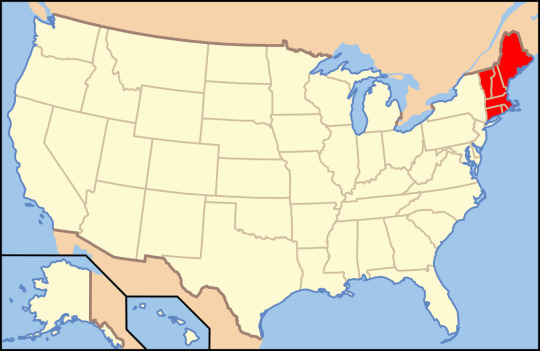
New England highlighted on a map of the U.S., comprising the states of Maine, Vermont, New Hampshire, Massachusetts, Connecticut and Rhode Island. The entire west side of the region borders New York State.
Enjoy. 🔥🇺🇸
1. Nationalities of Main Cast
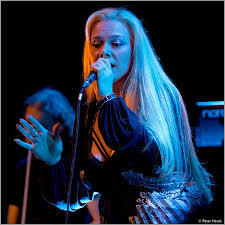



The weakest point, but worth mentioning. Three of the six human characters in Transitus, a majority and the most of any Ayreon album, are played by American singers: Amanda Somerville, Cammie Beverly, and Dee Snider. Dee Snider being the most notable because his character is this staunch, traditionalist patriarch guy who’s on Daniel’s back about the Old Ways, and from there I think it’s safe to assume this guy’s family has been in the spot they’re in for more than a few generations.
I personally really like integrating certain non-personality-related traits from irl singers into their characters, and I think nationality applies to that nicely in this context. 19th century New England aristocrats were usually one of two categories: generationally wealthy European wannabes that take an insane amount of pride in their colonial ancestry, or “self-made” business tycoons that made ungodly amounts of money during the Second Industrial Revolution.
More on that second category in a second, but given the very, very limited information we get on Dee’s character, he gives me more of that high-and-mighty old money vibe.
Also, with almost zero canon evidence: I am completely glued to the idea that The Soprano, played by a very Dutch Dianne van Giersbergen, is the ghost of Daniel and Henry’s mother. Like I will die on this hill. Coincidentally, Connecticut, a state I picked from New England almost entirely at random, was first colonized by Dutch settlers, setting it apart from a few other Northeast states. If we’re keeping with the Nationality of the Parent Characters Carrying Through From Real Life theme, then that would create a very strong tie between Daniel’s family and their home state, further emphasizing the father's prioritizing of retaining status and “proper breeding.”
2. Weirdly Specific Combo of Architectural Styles
I genuinely cannot think of any other place where these three buildings could possibly exist in close proximity to each other, like-
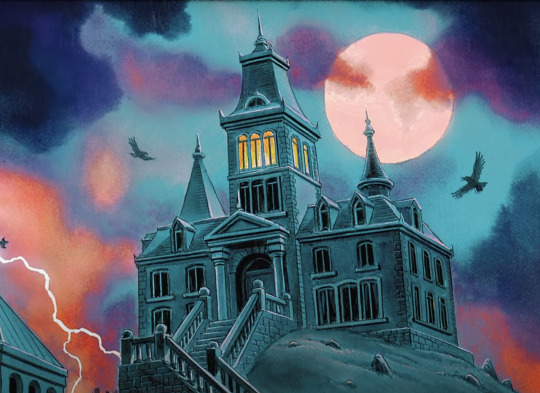
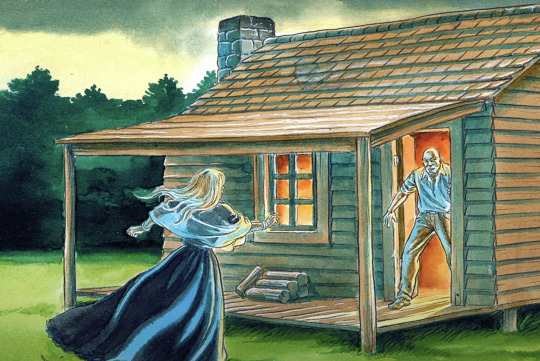
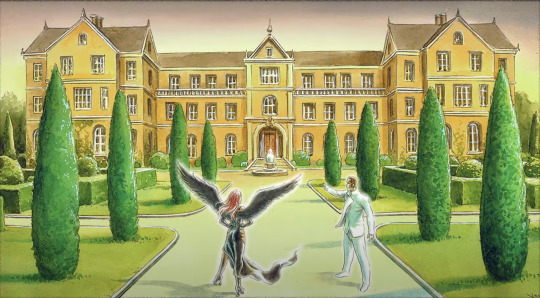
Daniel’s family’s house (bottom right) is by far the strongest visual argument you can make for Transitus being set in Britain, like that is an 18th century English manor house through and through. Fair enough, but:
The East Coast US is a bunch of former colonies that were under British rule in the Georgian period (1714-1837), hence the name “New England.” A lot of the architecture from that time is reflective of this, especially in the older Northern colonies. Southern ones tend to follow the Greek Revival/Neoclassical styles more.
I’d believe the Britain argument here if it wasn’t for the other two houses’ whole situation. Too much US-adjacent design present in this specific region for you to go “yea but the mansion, though” at the mansion that could also exist in said specific region.
As much as I don’t like this as a design choice in the comic: Abby’s parent’s house (bottom left) is a frontier log cabin. These became very, very common during Westward expansion, fueled by the Homestead Act in 1862, the Manifest Destiny Doctrine present throughout the 19th century, the California Gold Rush in 1848, etc… The style wasn’t exclusive to the West though, and a bunch are still standing in the rural East Coast.


Cabins in Blue Ridge, Virginia and Hampton, Connecticut, respectively
As I said, I think it’s just a very odd choice. Among other reasons, the only part of this house that’s plot-essential is that it has a set of stairs for Lavinia to snap her neck on, and these things are pretty much always single floor structures.
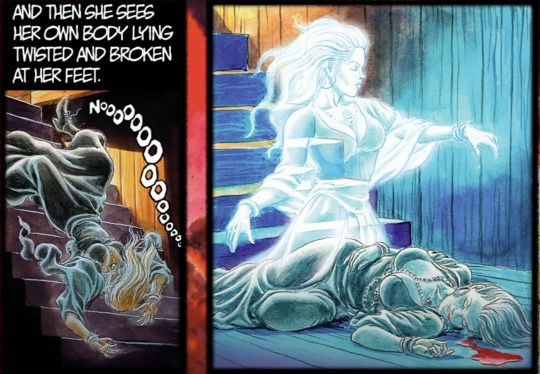
Girl, where do those even lead to???
I dunno. I just don't like it, even if it supports my point. It should have been a little two-story rowhouse. Moving on.
These houses existed outside the US. It’s a plain, utilitarian style that shows up all over the place in Europe, even if they’re more synonymous and symbolic to America.
The main house, though, Daniel and Abby’s, narrows it down a bit more. It really reminds me of the Second Empire style, popular in the Northeast and Midwest regions at the time.
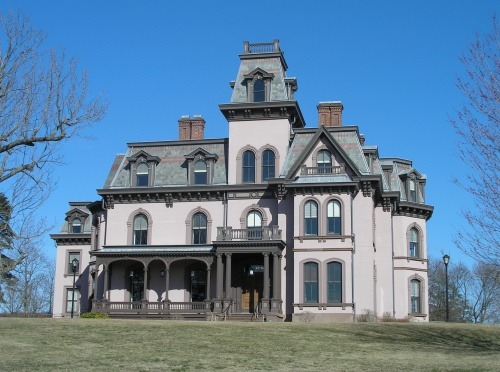
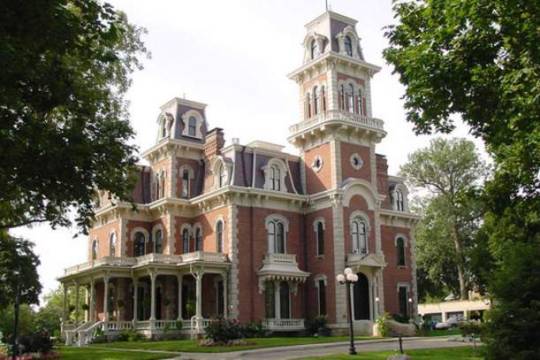
The John M. Davies house (Connecticut) and Terrace Hill (Iowa), both built in the mid-late 1860s.
Blocky base, mansard roof, giant statement piece (i.e. a tower) tacked on there somewhere.
The only issue with that guess is that it would make the house, at best, 25-30 years old. Second Empire was only a thing in the post-Civil War period, and the house is meant to be this ancient, haunted thing.
I had this idea for working around it a few months ago that it’s like…an older style that’s been updated in recent years? Say it’s originally a colonial era home (also plausible for New England) belonging to Daniel’s family. Makes sense, the base is still symmetrical and flat with two stories, steep roof, all that jazz.
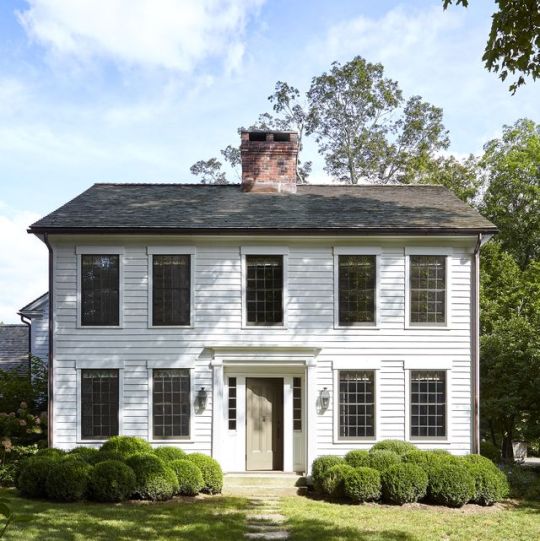

Washington, Connecticut (ca. 1750) and Hingham, Massachusetts (1721)
They clearly don’t use it themselves so maybe they rent it out? Maybe that’s part of where their money comes from; tenant properties and such. Maybe, understandably, nobody wants to pay to live in it because it’s old and run down and has a cemetery for a front yard, so they gut it and renovate, slapping some new age architecture over the top to make it more appealing.
It doesn’t work but the house finds a use eventually. It’s still old as hell, still American, plus you get the bonus representations of traditionalist vs progressive styles being combined, like the two people that live there.
...get it
Anyways, again: these all exist within sprinting distance of each other. I’d love some other suggestions but the Northeast is the only spot I know all three of them can comfortably exist in.
3. Historical Implications - The American Civil War (1861-1865)
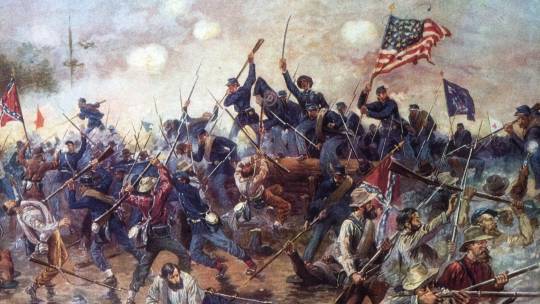
In January I finished this sort of…show bible for any and all Transitus HCs I had as an alternative to sending someone like 300 maxxed out rant-y text messages about it. Congratulations to @ay-miphae for somehow reading all of it.
Since it’s important to certain story elements, a section of the text is dedicated to a consolidated explanation of the American Civil War.
Kindly, a PDF of that section:
It’s deliberately written so someone with no prior knowledge of US history can follow it. That said, even if you are American and have the general gist of the war, I still think you should read it so you can really get where I’m coming from. It’s not something to be incorporated into a story lightly.
If you're not up for it, I at least think the intro paragraph speaks for itself in relation to my point:
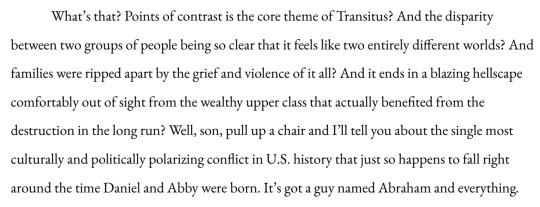
The war ended about 20 years before the album takes place and you’d be hard pressed to say it fits with its story’s themes, far beyond the surface level of its very real effect on American race relations (that were much more intense than those of England at the time):
The hypocrisy of the Union, as if the majority of the North wasn’t still segregated and racist as hell long after slavery was abolished.
The tension not just regarding race but socioeconomic class in the war years. Of particular interest was the fact that wealthy men could pay their way out of conscription, often viewing the war as a mere inconvenience rather than the system-altering mess that it was for everyone else.
Death. Just completely unprecedented amounts of it and unnecessarily so.
Your pick of the million and one ways it could have affected Daniel and Abby’s parents, and even Henry depending on how old you picture him.
Et cetera. You want a way to push the “Two Worlds” motif? Set the story in a Northern state two decades after a war fought over whether millions of people got to be treated like human beings or not, so impactful that the two sides of it are still so clearly, ridiculously discernible and will stay this way for another century and a half after.
As far as the possibility of setting Transitus in the South goes, fascinating as that could be, the plot of Act II makes it impossible. Interracial marriage was either void or outright criminalized in every single Southern state, until the ruling of Loving v. Virginia deemed the policies unconstitutional in 1967. There is no room for conflict over Abby receiving inheritance money - she and Daniel would have been straight-up arrested once Henry found out about them.
In the North, laws like this were repealed during or before the 1880s, if a state had them at all. In Connecticut’s case there were no laws ever prohibiting interracial marriage, but starting in the 1840s you were required to disclose your race in order to obtain a marriage license, which could create its own conflict with the risk of Daniel and Abby being exposed. Regardless of legal allowance, the practice was heavily frowned upon wherever you went, and the majority of them are recorded as being ordained in black churches, since white ones would turn them away and be well within their rights to.
A helpful reminder. 🔗
4. Main Setting - The American Gilded Age (1877-1900)

This was the point in my amateur "research" for this setting that I completely dug my heels in.
I mentioned the two sides of the 19th Century New England aristocracy - The dynastic, nobility-adjacent old money crowd, and the new money industrialists that rose to power during and after the Civil War.
Hey look, another (shorter) helpful PDF summary of a historical period:
Emphasis on "the wealthy elite using underhanded, exploitative practices to get what they want with no real consequences for it."
Henry fits...so perfectly into the category of these "robber barons" for me. Even if he's from a traditional, generationally wealthy family, he seems like enough of a greedy little cheat that he would force his way into this new crowd even if he didn't need to. It adds a few extra layers to a fairly archetypal 19th-century douchebag.
Henry being one of these Gilded Age industrialists sets him up as his family's main provider, allowing him to exert even more control over Daniel's life. Old money families had a severe distaste for these people, matching with Henry's extreme desperation to uphold his status. Even outside of higher social circles, these guys were hated by the general public and that was a 100% valid opinion. If Henry is this much more elevated above other characters in terms of wealth and the way he amassed it, it might make the insane jump from "jealous, nosy prick" to "murders an entire lower-class family for personal profit" a little more believable.
And, the most obvious point, the whole idea of this era, that "cartoonishly evil class divide" supporting the Two Worlds narrative.
The difference between Daniel and Abby's situations made all the more drastic, given that Henry may very well be one of (if not the) wealthiest men in the world in this prospective version of the story.
The nature of their wealth puts Henry, and by proximity Daniel, far more in the public eye than any British aristocrat would be. Daniel feels even more pressured and uncertain about his choices, even outside his family's expectations of him. Henry isn't just threatened by monetary loss after Daniel's death but cutthroat social humiliation, given who Daniel's inheritance is being released to.
Daniel is divided even further between his father's quiet, "safe" traditionalist lifestyle and his brother's much more forthright and totalitarian approach to everything. Maybe even tension created between Henry and his father for it.
Again, the stark difference between the post-War North and South, not exactly plot relevant but present in the setting.
The fact that the prosperity of Daniel's family is much more directly a result of the suppression of the poor and working class, the very difficult-to-navigate, set-in-stone power dynamic it creates in Daniel and Abby's relationship and how they come to terms with it.
And a little more on the Making-Shit-Up side: I have a troubling amount of extra characters I've used to fill plot holes that bother me, most of them servants, and trust me. The whole mass immigration aspect of this period makes character-building way more exciting. This is when the US Melting Pot idea really started, and it allows for a lot of different types of people to believably exist in a relatively limited setting. Christ, I even kept Abraham as an Englishman like his respective singer and it still makes sense within the world.
It's just...perfect. Arjen really picked the absolute perfect decade to set this story in for the sake of a throwaway 2084 joke.
5. The American Dream and the Tragic Fantasy of the Middle Class
This one is purely thematic, related to a more general national ideal than any one era or location (though I think the Gilded Age's presence boosts its effect). Oversimplified to all hell:
America is a very individualist society. It was founded on the idea of personal freedom and making your own way in the world with minimal resistance (or support) from an executive power, say, the British Empire. If you work hard and persevere, you can carve out the life you want and enjoy it. On paper, anybody can be anything, free from the restrictions of a tyrannical government or lineage-obsessed nobles. It's the ideal system, that benefits everyone who really wants it to.
Except it's just...not.
This isn't some groundbreaking concept. The American Dream is hypocritical as fuck and most people have figured this out by now. Sure, you can be anything you want in this country, no mountain is too high. So long as you are white, male, Christian, able-bodied and minded, not an immigrant, etc., etc.
Surely it's equal. Surely there are no unfair headstarts for people born into wealth and privilege, just like in Britain, and surely they will not use that advantage to lord power over the less fortunate with minimal consequences because they *earned* it and the government has no right to take it away. And surely, the people who really did work independently for what they have are not in a far more precarious position, as just a little bad luck can send them spiraling with nothing to fall back on.
...
And now, a small summary:
Daniel and Abby come from complete opposite sides of the social ladder, but are able to look past those differences because they care about each other as people. They are ridiculed and ostracized but they persist in the name of the life they chose (bada bing bada boom direct album quote 💃), and after enough time (and some pure luck), they get the house and make it their own. A quiet and steady spot, a safe middle ground between their two worlds.
One bad day and all of it is gone. Literally burned to the ground, and with it the character that all but stood for prosperity, change for the better and genuine human kindness.
The situation is then made exponentially worse when Henry, rich white jackass incarnate, steps onto the scene and twists the horror of it all into something that will benefit him. Doing so, mind you, by stepping on the backs of some select members of the lower class and tricking one through false promises of a shared reward to turn against her own. He fiddles with and fuels that fire while all previously mentioned genuine-human-kindness character can do is watch, and only after death does he get his comeuppance for it.
I figured it all fit together pretty well.
#this is the absolute trashfire of class and racial purity that is 19th century America...#...could be the setting of a story exploring the absolute trashfire of class and racial purity...#I couldn't wait this has been in my head forever#I am reading into this album way too fuckin much but my god it is FUN#genuinely curious where yall think it takes place#I seriously need to email Arjen and ask him about it#I think it's also worth mentioning that Lavinia being a Southerner would be a really interesting way to explore that cultural divide#idk#prog rock#rock opera#concept album#dee snider#cammie beverly#paul manzi#tommy karevik#amanda somerville#dianne van giersbergen#arjen lucassen#essay#basically#progressive waves art#ayreon#transitus#writing
14 notes
·
View notes
Text
With several of his landscape and nature paintings on a large wall and crowds of people trying to see them, Shen Wei mentally thanked for asking his professors to give him a senior student to assist him with all of that. They would have objected because he was a senior architecture student, if the senior in question wasn't who he was - to which Shen Wei thought that the Wu family had more fingers in that college than it seemed. It didn't matter, what mattered was that during that whole week, Wu Xie would be by his side, supporting him to go through all the trouble he had in having so much attention on himself - even though not all the people seeing the paintings were aware that the student in the corner was the artist. Wu Xie was relieved that everything worked out and he was able to be there for Shen Wei. His art was something deeply personal to him and Wu Xie knew how anxious he could get. If Wu Xie had been stuck in classes, all he'd do was worry about the other the entire time. He would ignore the blatant favoritism if it helped his lover feel more at ease through all of this. ... Zhao Yunlan gazed intently at the arts before him, the snow-capped mountains, the ethereal landscapes, the birds on branches, the peonies and koi. The huge green tree with strong roots. The blossoming plum tree. It was as if those images were photographs of things he had seen a long time ago, and that still remained vivid in his memory. With his hands in his pockets, he walked slowly along the entire length where that artist's paintings were displayed. Unlike the other paintings he had glimpsed upon arriving there, which although intended to be traditionalist, clearly looked modern, recent, these paintings before him now seemed to come from many times in the past, but distinctly painted by the same hands. They felt as if the artist's eyes had seen everything up close, the objects and the eras. Zhao Yunlan mocked himself, it wasn't like a ghost painted all that and enrolled in college.
It took me and @tazzy-ace 14 chapters to get here. I was waiting so eagerly for this. 😈
#guardian#dmbj#shen wei#zhao yunlan#wu xie#weilan#guardian x dmbj crossover#guardian fanfic#d#dmbj fic
4 notes
·
View notes
Text
History Of Mandalore
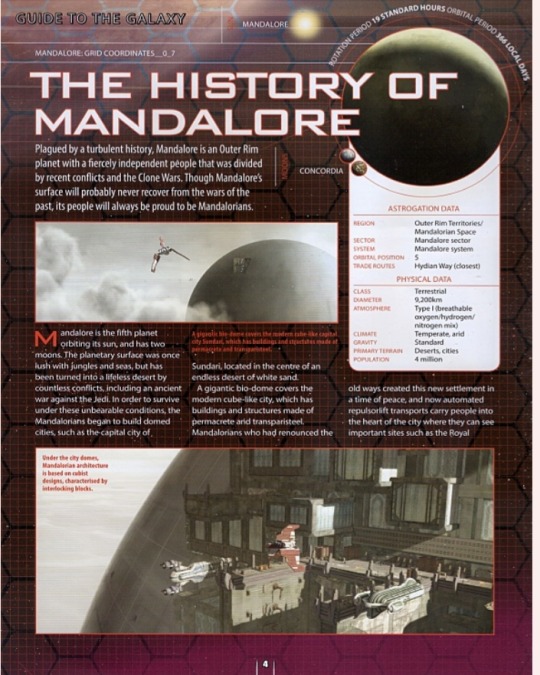
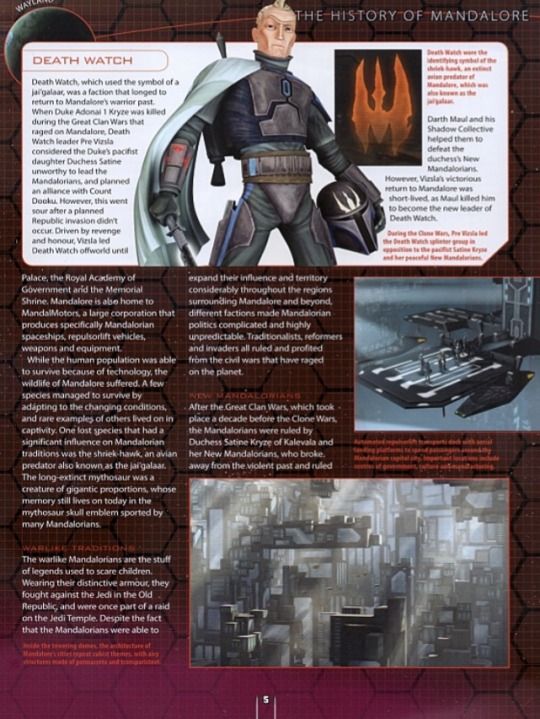
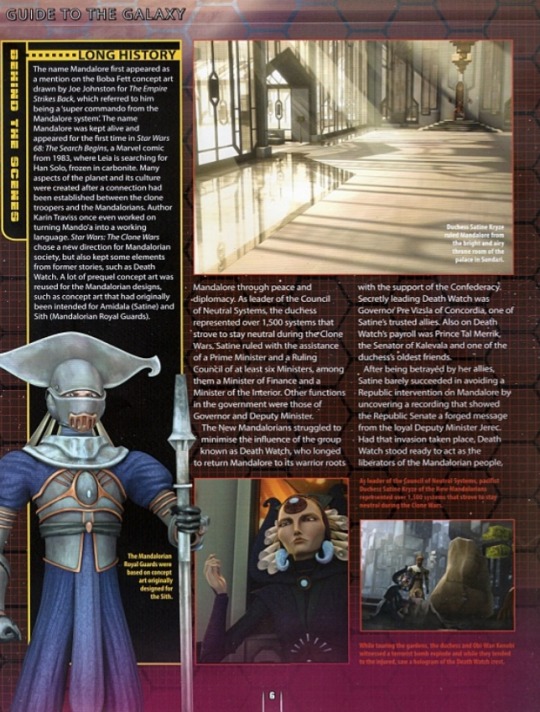
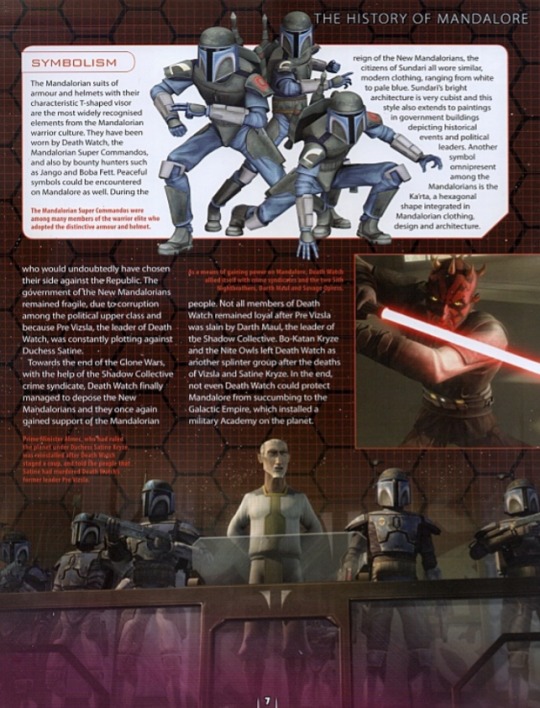
Build the Millennium Falcon: Guide to the Galaxy - The History of Mandalore
Sorry for the quality of the images, but it was the best ones I had
Text on the images is written down for those whose image isn't loading or simply find the quality of the images too hard to read, after the break.
I will handle first the actual text, then Death Watch and Symbolism, and finally the Behind the Scenes text. All the red (and yellow) texts will appear between two brackets at the end of the section that they appeared in.
(Mandalore: Grid Coordinates_0.7
Rotation period 19 Standard Hours, Orbital Period 366 local days; Moons: Concordia;
Astrogation Data:
Region - Outer Rim Territories/Mandalorian Space
Sector - Mandalore Sector
System - Mandalore System
Orbital Position - 5
Trade Routes - Hydian Way (closest)
Physical Data
Class - Terrestrial
Diameter - 9,200 km
Atmosphere - Type I (breathable oxygen/hydrogen/nitrogen mix)
Climate - Temperate, arid
Gravity - Standard
Primary Terrain - Deserts, cities
Population - 4 million
HISTORY OF MANDALORE:
Plagued by a turbulent history, Mandalore is an Outer Rim planet with a fiercely independent people that was divided by recent conflicts and the Clone Wars. Tough Mandalore's surface will probably never recover from the wars of the past, its people will always be proud to be Mandalorians.
Mandalore is the fifth planet orbiting its sun, and has two moons. The planetary surface was once lush with jungles and seas, but has been turned into a lifeless desert by countless conflicts, including an ancient war against the Jedi. In order to survive under these unbearable conditions, the Mandalorians began to build domed cities, such as the capital of Sundari, located in the centre of an endless desert of white sand.
A gigantic bio-dome covers the modern cube-like city, which has buildings and structures made of permacrete and transparisteel. Mandalorians who had renounced the old ways created this new settlement in a time of peace, and now automated repulsorlift transports carry people into the heart of the city where they can see important sites such as the Royal Palace, the Royal Academy of Government and the Memorial Shrine. Mandalore is also home to MandalMotors, a large corporation that produces specifically Mandalorian spaceships, repulsorlift vehicles, weapons and equipment.
While the human population was able to survive because of technology, the wildlife of Mandalore suffered. A few species managed to survive by adapting to the changing conditions, and rare examples of others lived on in captivity. One lost species that had significant influence on Mandalorian traditions was the shriek-hawk, an avian predator also known as the jai'galaar. The long extinct mythosaur was a creature of gigantic proportions, whose memory still lives on today in the mythosaur skull emblem sported by many Mandalorians.
[A giantic bio-dome covers the modern cube-like capital city Sundari, which has buildings and structures made of permacrete and transparisteel.
Under the city domes, Mandalorian architecture is based on cubist designs, characterized by interlocking blocks.]
Warlike Traditions
The warlike Mandalorians are the stuff of legends used to scare children. Wearing their distinctive armour, they fought against the Jedi in the Old Republic, and were once part of a raid on the Jedi Temple. Despite the fact that the Mandalorians were able to expand their influence and territory considerably throughout the regions surrounding Mandalore and beyond, different factions made Mandalorian politics complicated and highly unpredictable. Traditionalists, reformers and invaders all ruled and profited from the civil wars that have raged on the planet.
[Inside the towering domes, the architecture of Mandalore's cities repeat cubist themes, with airy structures made of permacrete and transparisteel.]
New Mandalorians
After the Great Clan Wars, which took place a decade before the Clone Wars, the Mandalorians were ruled by Duchess Satine Kryze of Kalevala and her New Mandalorians, who broke away from the violent past and ruled Mandalore through peace and diplomacy. As leader of the Council of Neutral Systems, the duchess represented over 1,500 systems that strove to stay neutral during the Clone Wars. Satine ruled with the assistance of a Prime Minister and a Ruling Council of at least six Ministers, among them a Minister of Finance and a Minister of the Interior. Other functions in the government were those of the Governor and Deputy Minister.
The New Mandalorians struggled to minimise the influence of the group known as Death Watch, who longed to return Mandalore to its warrior roots with the support of the Confederacy. Secretly leading Death Watch was Governor Pre Vizsla of Concordia, one of Satine's trusted allies. Also on Death Watch's payroll was Prince Tal Merrik, the Senator of Kalevala and one of the duchess's oldest friends.
After being betrayed by her allies, Satine barely succeeded in avoiding a Republic intervention on Mandalore by uncovering a recording that showed the Republic Senate a forged message from the loyal Deputy Minister Jerec. Had that invasion taken place, Death Watchstood ready to act as the liberators of the Mandalorian people, who would undoubtedly have chosen their side against the Republic. The government of the New Mandalorians remained fragile, due to corruption among the political upper class and because Pre Vizsla, the leader of Death Watch, was constantly plotting against Duchess Satine.
Towards the end of the Clone Wars, with the help of the Shadow Collective crime syndicate, Death Watch finally managed to depose the New Mandalorains and they once again gained support of the Mandalorian people. Not all members of Death Watch remained loyal after Pre Vizsla was slain by Darth Maul, the leader of the Shadow Collective. Bo-Katan Kryze and the Nite Owls left Death Watch as another splinter group after the deaths of Vizsla and Satine Kryze. In the end, not even Death Watch could protect Mandalore from succumbing to the Galactic Empire, which installed a military Academy on the planet.
[Automated repulsorlift transport-decks with aerial landing plataforms to speed passengers around the Mandalorian capital city. Important locations include centres of government, culture and manufacturing.
As the leader of the Council of Neutral Systems, pacifist DDuchess Satine Kryze of the New Mandalorians represented over 1,500 systems that strove to stay neutral during the Clone Wars.
While touring the gardens, the duchess and Obi-Wan Kenobi witnessed a terrorist bomb explode and while they tended to the injured, saw a hologram of the Death Watch crest.
Prime Minister Almec, who had ruled the planet under Duchess Satine Kryze, was reinstalled after Death Watch staged a coupp, and told the people that Satine had murdered Death Watch's former leader Pre Vizsla.
As a means of gaining more power on Mandalore, Death Watch allied itself with crime syndicates and the two Sith Nightbrothers, Darth Maul and Savage Opress.]
Death Watch
(Wayland is a possible planet shown behind the white box of text that the Death Watch section is in.
OP here, is it possible that Wayland is the name of the second moon? Food for thought for those who are reading.)
Death Watch, which used the symbol of a jai'galaar, was a faction that longed to return to Mandalore's warrior past.
When Duke Adonai 1 was killed during the Great Clan Wars that raged on Mandalore, Death Watch leader Pre Vizsla considered the Duke's pacifist daughter Duchess Satine unworthy to lead the Mandalorians, and planned an alliance with Count Dooku. However, this went sour after a planned Republic invasion didn't occur. Driven by revenge and honour, Vizsla led Death Watch offworld until Darth Maul and his Shadow Collective helped them to defeat the duchess New Mandalorians.
However, Vizsla's victorious return to Mandalore was short-lived, as Maul killed him to become the new leader of Death Watch.
[Death Watch wore the identifying symbol of the shriek-hawk, an extinct avian predator of Mandalore, which was also known as the jai'galaar.
During the Clone Wars, Pre Vizsla led the Death Watch splinter group in opposition to the pacifist Satine Kryze and her peaceful New Mandalorians.]
Symbolism
The Mandalorian suits of armour and helmets with their characteristic T-shaped visor are the most widely recognized elements from the Mandalorian warrior culture. They have been worn by the Death Watch, the Mandalorian Supper Commandos, and also by bounty hunters such as Jango and Boba Fett. Peaceful symbols could be encountered on Mandalore as well. During the reign of the New Mandalorians, the citizens of Sundari all wore similar, modern clothing, ranging from white to pale blue. Sundari's bright architecture is very cubist and this style also extends to paintings in government buildings depicting historical events and political leaders. Another symbol omnipresent among the Mandalorians is the Ka'rta, a hexagonal shape integrated in Mandalorian clothing, design and architecture.
[The Mandalorians Super Commandos were among the many members of the warrior elute who adopted the distinctive armour and helmet.]
Behind the Scenes: Long History
The name Mandalore first appeared as a mention on the Boba Fett concept art drawn by Joe Johnson for The Empire Strikes Back, which referred to him being a 'super commando from the Mandalore system'. The name Mandalore was kept alive and appeared for the first time in Star Wars 68: The Search Begins, a Marvel comic from 1983, where Leia is searching for Han Solo, frozen in carbonite. Many aspects of the planet and its culture were created after a connection had been established between the clone troopers and the Mandalorians. Author Karen Traviss once even worked on turning Mando'a into a working language. Star Wars: The Clone Wars chose a new direction for Mandalorian society, but also kept some elements from former stories, such as Death Watch. A lot of prequel concept art was reused for the Mandalorian designs, such as a concept art that had been originally intended for Amidala (Satine) and Sith (Mandalorian Royal Guards).
[The Mandalorian Royal Guards were based on concept art originally designed for the Sith.]
#star wars#sw#mr talks#mandalorians#build the millennium falcon#guide to the galaxy#history of mandalore#text of the images under the break#satine kryze#pre vizsla#death watch#new mandalorians#mandalore
28 notes
·
View notes
Text
Zavlakya
Alright, today, you're getting THE MOST incoherent city-dump. Sorry. I could try to format this but like... energy. So this is just what I actually just wrote in my notes for New City November a few years back.
Here are the prompts:

Day #3: Resources in this city?
-Lots of water-based plants and woods like Salt Palms, Mallow, Sacred Feathers, Cherimanus, Witch's Hours, Olives, Seaweed
-Sulfur & Hot Springs
-Salt from the ocean
-Peat moss & coal
-Seahens/seacocks, Solbirds, Monk seals, sardines, frogs, solbirds, deer, goats, squat lobster
-Gold, minor amounts of silver and copper, nickel, aluminum
-Somenium is a type of silk that flows down through waterfalls and rivers nearly year round--but most prominently during the warming of spring. Somenium is extremely durable, holds and protects dyes from the sun, and is also very lightweight. Due the structure of the fibers, catches and holds Ysse--the extremely cold particles that makes up my magic. Somenium is produced by a specific kind of caddisfly on the Upper Contient. But the Aftokratorian scientists have not confirmed this specifically. Seeresses and illuminators have woven somenium into as many things as possible for forever in this town...
Day #5 Architecture:
The traditional Svanihk styles are not generally as advanced as those in Telethens--the architectural height of the world--but since the growth of this city was largely guided by Yeulia, they stand out sharply from other structures built at the same time period (I imagine this city was founded... oh... 200ish years ago?). The rooftops are typically mildly conical--inspired by their yurt-based roots. Blue-toned glass windows are a newer addition--but due to the humidity, they are typically left open anyway except in the winter. While moss definitely overgrows the buildings and trees, the people make a point of cleaning it off at least once a year to maintain the stonework set by their precious Seeress.
Day #6 --Governance Historically
In Svanihk culture, Tsars and their Tsarinas have ruled the land. (Tsars and tsarinas are essential landed nobility but without the gender roles found in the traditional meaning--Tsars are the rulers, tsarinas are the relatives) However, under the new-ish laws of the Aftokratoria over the last 70-odd years, the Tsars have progressively lost power in favor of elected officials.
Today, the Tsars and Tsarinas in this city have say in government through monetary means and land-ownership. While some senators, particularly those in Telethens such as Senator Diacaius and ex-Senator Tarchus, are very pro-wealth redistribution, traditionalists and the Senate at large oppose the motion to simply "steal" wealth from the rich and give it to "random people for no reason".
The Seeresses of Telethens also have quite a bit of say over laws as well--seeing as they control large swaths of the airship supply in this city. If Yeulia ever arrives in town, her word becomes law unofficially.
And lastly, the head elected official is the Governor. The Governor is supposed to be in charge of enacting the people's will, and then will appoint everyone else they want in the government. They are reelected every year at the end of Spring--at the beginning of the safest travel season. There are no term limits. Their power is quite broad, as they can set taxes, laws, and such as they please within the city HOWEVER anything they do can be vetoed by the Senate or the Philosopher King or angry mobs. The Governor of this city in particular is known for being pretty in-line with the desires of the Senate and the local Tsar and Tsarina
Day #7--Most Famous Person
I already told you about the Seeress and the Stonemason (whom I'm officially naming Somenia and now the city's silk is named after Yeulia's lover). I have decided to name the city Zavlakya and the reigning Tsar family, Ivodra. But today, let me tell you about a more modern famous person: The elected Senate representative of Zavlakya is a Telethenian (pale skinned, pale haired) girl named Pythas.
Senator Pythas has basically formalized the theory of modern mathematics. Born to a rich shipwright family, Pythas was tutored alongside an Ivodra family Tsarina. Pythas was always very shy but very intelligent. Her tutor always encouraged her to speak up, and thus the Tsarina got very jealous of her. As such, she decided not-to go into Philosophy at first--despite that being her passion. While working a terrible gig with long hours as a secretary at the Tsarina's shipmaking company, she discovered the Pythasian Theorem at age 17. She told the Tsarina who published the work and claimed the discovery as her own.
Pythas allowed it but secretly published her own, superior book titled the Symphony of the Planets--in which she not only demonstrated the Pythasian Theorem more clearly but used it to explain the movement of the stars at age 19. The Tsarina was furious and bitter and fired her, so Pythas had no choice but to pursue her dream as a Philosopher--standing on streetcorners and tutoring those who would listen. She was wildly courted by every shipwright company in town, thirsty to sponsor her, and even the Seeresses were impressed.
Gaining confidence and with the help of the Tsar himself, she ran for Senate which she won at age 24--5 years junior to Senator Imedea, the second Senator of Zavlakya
Day #8: What do people value?
In the Svanihk culture generally, people value humanity, life, and education. Telethenians (those from the Isle of Telethens and generally the group with more representation in the government) tend to value rationality, truth, and the acquisition and application of knowledge. Both cultures work well together in the Aftokratoria.
In Zavlakya specifically, they value truth and creation. The value of these things is largely due to their reliance on and prosperity from ships and their sails. However, more than anywhere else in the Svanihk cities, this leads to an emphasis on acquisition of wealth and prosperity.
Like everywhere in the Aftokratoria, it's a meritocracy of sorts but there is definitely more "merit" to being a shipwright or someone who makes physical things and less value on more abstract arts. Even Philosophers have less social clout here than elsewhere because their work is more abstract--with the exception of Senators Pythas and Imedea.
Day #10 - Transportation
While airships exist, they are basically all used by the military and the government with almost none available to the general public. Normal ships and fishing boats, on the otherhand, are far more commonly available to civilians--though the military is also responsible for building roads and running the mail and other major engineering feats and don't necessarily just fight things. Roads are, of course, the necessary precursor to easy carriage transportation. They use horses to pull their carriages.
The Aftokratoria is a largely Communist nation with universal basic income determined by one's job sector and government coordinated transportation. So most of this stuff is free. It's not like civilians can never ride on or fly airships--sometimes they do but it's usually through luck or circumstance.
DAY #11 Imports & Exports
Primary Imports:
Grains
Lumber
Dyes
Medicinal things
Ores & Metal
Golems Primary
Exports:
Sails
Ships (Air and Sea)
Sailors
Day #12: Art
Known primarily for weaving Somenium silk, different weaves and patterns have different meanings based in Svanihk fortune telling tradition. Often, the seeresses weave their memories and visions of the future into the fabric--and help sailors who visit the city to do the same.
Also, they also sing a lot of sea shanties, have an opera based on organs, singing, and street organs, and are the first city to paint primarily on canvas instead of wood. The Aftokratoria invented realism as a painting method and they primarily use turpentine and safflower oil
Day #14--Professions
People in Zavlakya are known for being sailors and shipwrights and then all the sub-categories of things that go into that--particularly engineers, carpenters, and sailweavers. Zavlakya is also known for having an especially safe place for women--especially women who have been hurt by sailors or have lost husbands--amongst the Seeresses at their city Shrine.
Day #15 -- Wealth Distribution
There is not that great of a wealth gap between the rich and the poor--though it still exists. 70-odd years or so ago, the first Telethenian-style elections were held in Zavlakya and at this time, Communism/government-imposed minimum wage took hold. However, part of getting the Tsars to cooperate was allowing them to keep all their wealth. That being said, there are very few who are overlooked by the system--the government accounts for all citizens except in case of clerical errors or other extreme circumstances. Crime is incredibly low because why would you steal if you can more or less have whatever you need at any time? That being said, not every citizen has the opportunity to make lavish donations to the government or the Ecclesia or own several acres of orchards or convince artists to make art specifically for them... Only the rich do.
Senator Diacaius Praefori and many citizens in Telethens are pro-wealth redistribution for the Tsars but the Tsars are not so inclined
Day 16--Current Affairs
The biggest current issue in the Public Discourse in Zavlakya is the kind of power we want our leaders--elected and not--to hold. Should our Senators really dictate the transition of conquered peoples into our rule? Should our Seeresses and Illuminators dictate our values or should our Philosophers and forward thinkers? Should the Philosopher King be able to blow up entire cities with her ring finger? These are all questions being discussed with poor Svanihk and Telethenian people being pro-Philosophers and pro-not-blowing up things while rich Svanihk people tend to be pro-Seeresses and pro-Conqueroring people. That being said, they really love the Philosopher King here, just think maybe she shouldn't have nuked an island out of existence...
Day 17 Zavlakya's Outsiders
Due to the production-focus of the culture, they often are competitive with outsiders and proud when they outdo the other cities who aren't competing with them. They're kinda like New Yorkers who are like "Oh, you haven't seen NEW YORK busy". The kind of people who have side hustles to their side hustles. The government might dictate what kind of raise they get, but it's also a moral obligation to work hard.
Also, Zavlakihks aren't a fan of sporty, countryside towns with lots of horses--they consider horse racing to be the biggest waste of time. You know, unlike boat races. Those are great and perfect and useful
Day 18: Outsiders' Opinions of the City
(Idk if these aspects are cohesive cuz I just made em up but I like it so far) Most outsiders of the city see Zavlakyihks (as I realized it would be because they're NOT A ROMANCE LANGUAGE) as overly obsessed with their work and, in plays and such, those with Zavlakyihk accents frequently take on the "neglectful parent/spouse" stereotype. They being said, Zavlakyihk Seeresses are also fetished in the whole western half of the Aftokratoria for being beautiful ladies high in the mountains and who weave silks. Due to their history as a women's shelter, these women are known for being especially chaste and uninterested in men. To win one's trust is a sign of incredible nobility. That being said, a majority of the Seeresses in Zavlakya are VERY VERY gay just because of the legends in the city. There's a general expectation in the city that young people will meet their SO and then do incredibly productive things together as a power couple. This Zavlakyihk Romance has also become a trope in Western art.
Day 19: What's currently threatening the city?
There's also an election in Spring in which the Tsar is running against both Imedea and Pythas. They are expected to win, but it would be a hit against the democracy of the Aftokratoria to have the Svanihk elite win instead...
Day 20: Languages
In Zavlakya, they speak Svanihk and Telethenian.
Davyevi, minihk ken Belle ziri. Svan kevos'hi ziri.
Day 21: A Shop
Filia and Syeva's workshop is higher on the mountain, at the edge of the lake. The vaulted space is filled with elegant looms and more elegant voices. Filia sings and you can hear her high, sweet voice even down at the waterway below. Her singing is timed to the churning of machines and to the boiling pots of safflower, pomegranate, and mallowblooms. Syeva weaves and grinds. Filia pans for somenium and spins. Together, the Seeresses turn their creations into great sails and wings stretched across those thin, strong frames.
Belle's Note: I don't remember this at all lololol
Day 24: The City's Heart
Zavlakya is a city for the beautiful and the practical. The fast paced bustle is the Gem of the West, a haven of religion and industry. From the shipwrights and the trade port in the harbor to the weavers and spinners at the mountain lakes, water flows through the heart of Zavlakya. And the rising middle class here make the most of every drop. That is the essence of what Zavlakya is about
#fantasy city#fictional city#worldbuilding#fantasy world#fantasy illustration#environment art#writerblr#concept design#concept art#concept illustration#forest city#Yssaia#Amaiguri
3 notes
·
View notes
Text
Apparently there's a part in Osamu Tezuka's Phoenix, wherein a humanity at the end of it's rope faces this idea of an inevitable end. It's noted that many people are dressing in the fashion of old aristocracy, as sort of a way to imitate the grandeur of the past within a present where they have no hope. I wonder about that idea. I've seen people talk of the idea that a lot of culture has become stagnant; repeating endlessly the same movie ideas and pushing the same concepts as a way to remain relevant and generate money safely rather than fund the new. How many ideas have become set and fail to innovate outside of that; in a lot of political thought people note that the major parties are often very out-of-synch with the desires of even their own followers. How technology, now that computers have become established and there are clear winners in things like smartphones, no longer build forward but now just maximize profits. And, outside of that, how there is a profound sense of doom among people; fear for the climate, fear for housing and cost of living, fear of a lack of fulfilment; and it sort of comes from this idea that society is really failing to meet people's needs. That all seems to correspond to movements which ideate the past in many ways. Neo-traditionalists are the obvious one, but even those young people invested into counterculture is parroting a lot of the ideas of the USSR as sort of an alternate idea; but this too is obsessing over the old in a different way.
It is... Interesting to see this reflected in older series. I watched a video on the way anime will often have these Space Prussians, and this idea of cultural regression and imitation of the past is similar among them. It's interesting to look at now, in a time when so many people do not see much of a future and are similarly obsessed with what has come before:
youtube
...I do think something new can grow from these things, though. Thoughts which emerged from both have spawned influence in, for example, urbanist circles - The focus on walkable communities not driven by car dependency appeals to those who hate corporations, while the human-scaled buildings goes hand-in-hand with traditional architecture. That's just the first example which comes to mind, of course, in how new thought can come from examining the old and combining that with the tensions we face now. Ultimately life isn't an anime, and simply moves forward. The movements we see do not regress to a point and stop; we gain new schools of thought along the way. You can see the underlying idea in many places, of learning from a past which has been discarded in order to find a path into the future, I think. It's not all uh, evil, as such.
But that is to say... These old anime, with their rather dystopic space empires built up to resemble old-world aristocracy, may be worth examining nowadays when you can sorta see parallels in real-world movements
4 notes
·
View notes
Text
Pulling the lever builds a Trolley By building a trolley, you will reduce urban sprawl, improve the economy, make cities more accessible to young people and the elderly, emphasize human-scaled and traditionalist architecture, and save hundreds of people through a reduction in air pollution and a lower amount of car accidents But if you do so, you might have to sit next to a homeless person if you voluntarily choose to ride it Do you pull the lever?

678 notes
·
View notes
Text


For over four decades Helmut von Werz (1912-90) shaped and critically accompanied the architectural goings-on in Munich: with the founding of his architectural firm in 1946 Werz jumped into the maelstrom of postwar reconstruction, a heavily pressing task in the widely destroyed city, that called for the quick restoration of infrastructure, schools, hospitals and other public buildings. At the same time he also engaged in the discussion surrounding the reconstruction or radical demolition of historic buildings: in this context von Werz assumed the role of mediator who liaised between radical modernists and traditionalists. In this capacity he also was supported by Johann Christoph Ottow who had joined the office in 1952.
From the 1952 onwards the partners consecutively realized a number of exemplary schools, hospitals, protestant churches and office buildings that gained them nation-wide recognition. In view of the scope of projects the partnership in 1971 was extended to Erhard Bachmann and Michel Marx who then got involved in one of the firm’s landmark buildings: the Archäologische Staatssammlung in Munich, completed in 1975, and easily identifiable by its corten steel facade. Other major but occasionally criticized projects include the Bavarian Broadcasting building with its characteristic high-rise, the Parkstadt Bogenhausen and Hasenbergl housing developments as well as the „Ramses“ housing tower.
Against the background of his significant contribution to the architectural appearance of Munich the present monograph was long overdue: published by Birkhäuser in 2014 and edited by Cordula Rau & Georg von Werz it collects a large part of the architectural firm’s built work. Organized along typologies the book gathers a total of 25 realized projects, largely presented in historic photos, plans and current photographs by Florian Holzherr. Since almost every project is comprehensively documented the reader is able to discover one of the firm’s primary virtues, namely the attention to detail. The latter also holds true for the book which provides a concise and beautifully illustrated overview of a pivotal Munich firm’s architectural output. Warmly recommended!
#helmut von werz#monograph#architecture#germany#nachkriegsarchitektur#nachkriegsmoderne#architecture book#birkhauser#book
20 notes
·
View notes
Text
Charlotte's Bridal Scene: Where Southern Grace Meets Haute Couture
The quest for the perfect wedding dress Charlotte brides embark upon is a journey filled with excitement and possibility. In the heart of the Queen City, the bridal landscape has transformed into a sophisticated haven where traditional Southern charm meets contemporary bridal fashion, with Winnie Couture leading the way in exceptional bridal experiences.
When exploring bridal shops Charlotte offers, brides discover a world where luxury and innovation converge. The current collections showcase an impressive array of designs that cater to modern sensibilities while honoring timeless elegance. The bridal gown Charlotte selection has evolved to include cutting-edge fabrics and innovative designs that speak to today's sophisticated bride.
The wedding dress Charlotte scene has witnessed a surge in demand for several key trends. Luminous silk crepe gowns with clean lines dominate the modern minimalist movement, while intricate lace designs with pearls and crystal embellishments satisfy the romantic traditionalist. These gowns often feature dramatic elements like statement backs, innovative sleeves, and architectural details that create unforgettable silhouettes.
Within the bridal shops Charlotte landscape, certain styles have emerged as clear favorites among Queen City brides:
- Ball gowns featuring translucent bodices with 3D floral appliqués
- Slim-fitting crepe dresses with dramatic cathedral trains
- A-line silhouettes incorporating Italian lace and French tulle
- Modern minimalist gowns with unexpected structural elements
- Convertible designs offering multiple looks in one gown
The bridal gown Charlotte market has embraced innovative fabric technologies and design elements. Today's brides are drawn to stretch crepe that offers both comfort and elegance, alongside traditional favorites like mikado silk and organza. Textural elements such as geometric laces, metallic threading, and dimensional appliqués add modern sophistication to classic silhouettes.
For those searching for their perfect wedding dress Charlotte venues provide an ideal backdrop for various styles. Whether planning a grand celebration at a historic estate or a modern soirée in an urban setting, brides can find gowns that complement their venue and personal style. The current collections feature versatile designs that photograph beautifully in any setting.
The bridal shops Charlotte scene has evolved to offer an elevated shopping experience. Private styling suites provide an intimate setting where brides can explore different silhouettes while receiving expert guidance. These personalized appointments ensure each bride discovers the perfect gown that aligns with her vision and enhances her natural beauty.
Contemporary brides visiting bridal gown Charlotte locations are increasingly drawn to sustainable and ethically produced wedding dresses. This growing trend has led to the introduction of eco-friendly fabrics and responsible production practices without compromising on luxury or style.
Customization has become a key element in the Charlotte bridal experience. From adding personal touches like family heirlooms to modifying necklines and trains, brides can create truly unique wedding day looks. Popular modifications include:
- Detachable overskirts for ceremony-to-reception transformations
- Custom sleeve options ranging from classic to contemporary
- Personalized train lengths and bustling styles
- Modified necklines and back designs
- Custom beading and embellishment placement
The wedding dress Charlotte selection continues to evolve with fashion-forward elements while maintaining the sophistication expected in luxury bridal wear. Innovative details such as invisible support structures, lightweight corsetry, and strategic seaming ensure both comfort and elegance throughout the wedding day.
As Charlotte's bridal industry flourishes, the city has become a destination for brides seeking exceptional bridal fashion. The key to success lies in starting the search early and remaining open to different styles, as many brides discover their perfect gown may differ from their initial vision.
The bridal gown Charlotte experience encompasses more than just finding a dress; it's about creating memories and celebrating individual style. Each appointment is crafted to ensure brides feel special and supported throughout their journey to finding the perfect gown.
In Charlotte's dynamic bridal scene, the focus remains on providing an exceptional experience for every bride who walks through the door. As wedding trends evolve, the commitment to outstanding service and unforgettable moments continues to define the Charlotte bridal shopping experience, making it truly special for every bride who begins her wedding dress journey in this beautiful Southern city.
#WeddingDressesCharlotte #WeddingDressCharlotte #BridalGownCharlotte #WeddingGownCharlotte
0 notes
Text
Point Cloud to BIM for Conservation Architecture

Point cloud innovation, joined with Building Data Modeling (BIM), is changing preservation design by giving remarkable exactness and effectiveness in saving memorable designs and social legacy locales.
Laser filtering catches a huge number of exact data of interest, making nitty gritty 3D models of existing structures.
These point clouds are then changed over into BIM models, permitting preservation engineers to envision, record, and plan intercessions with upgraded accuracy.
This strategy guarantees that remodels and rebuilding efforts keep up with compositional honesty while working with smooth task arranging, struggle discovery, and supportable design arrangements.
What is Point Cloud Technology?
Point cloud information is basically an assortment of millions of 3D directions (points) caught through laser examining, frequently alluded to as reality catch.
Each point addresses a piece of a structure's surface, shaping a computerized 3D "finger impression" of the actual construction. This innovation takes into consideration exact replication of the structure's math, catching fine subtleties that conventional estimating devices can't accomplish.
For legacy structures, where each engineering point of interest is urgent, this accuracy is fundamental. Point cloud filtering furnishes traditionalists with a precise establishment to base their reclamation endeavors, offering experiences into each corner, cleft, and secret component.
Benefits of Point Cloud to BIM in Conservation Architecture
Enhanced Data Accuracy and Visualization:
Point cloud to BIM guarantees that planners and moderates have the most reliable and outwardly rich data to work with. By changing over point cloud information into savvy BIM models, preservation projects are better arranged and executed with nitty gritty 3D perceptions of the site.
Streamlined Project Planning:
The mix of point cloud information with BIM upgrades project arranging. Designers can survey existing designs, picture expected changes, and distinguish clashes before they emerge, saving time and lessening exorbitant mix-ups during redesign.
Accurate Documentation:
Point cloud to BIM makes profoundly exact documentation of legacy locales. This is basic while working out material expenses, arranging underlying fortifications, and acquiring endorsements from legacy safeguarding specialists.
Speeding Up Renovation Projects:
With an exact computerized model within reach, protection planners can make speedy emphasess and updates to their arrangements. This is particularly valuable in redesign projects where time-delicate choices are required.
Facilitating Safe Demolition:
Point cloud-based BIM models give all the vital data to protected and key destruction while managing decaying or unsound pieces of notable structures. These models permit groups to disconnect explicit regions, guaranteeing wellbeing and insignificant harm to encompassing designs.
Challenges in Implementing Point Cloud to BIM
Integration Issues:
Existing work processes could expect change in accordance with completely coordinate point cloud innovation. Groups need preparing to embrace the new cycles without upsetting laid out rehearses.
Cost and Resource Constraints:
Carrying out point cloud to BIM includes huge interest in laser examining gear (While rental choices are accessible) talented faculty, and specific programming, which can be expensive for more modest undertakings or associations with restricted spending plans.
Preservation of Cultural Heritage Sites:
Across the globe, point cloud to BIM is being utilized to safeguard antiquated landmarks, palaces, and socially critical designs. This innovation permits traditionalists to keep up with these destinations' verifiable validness while guaranteeing they are protected and manageable for people in the future.
Future Trends in Point Cloud Technology for Conservation
The fate of point cloud to BIM in preservation design looks encouraging. Progressions in LiDAR are working on the nature of sweeps, considering considerably more nitty gritty information catch.
In the mean time, simulated intelligence and AI are starting to assume a part in mechanizing the examination of point cloud information, empowering quicker and more productive handling.
As innovation propels, the combination of point cloud and BIM is set to rethink how engineers approach protection projects, making conservation more exact, proficient, and reasonable.
0 notes